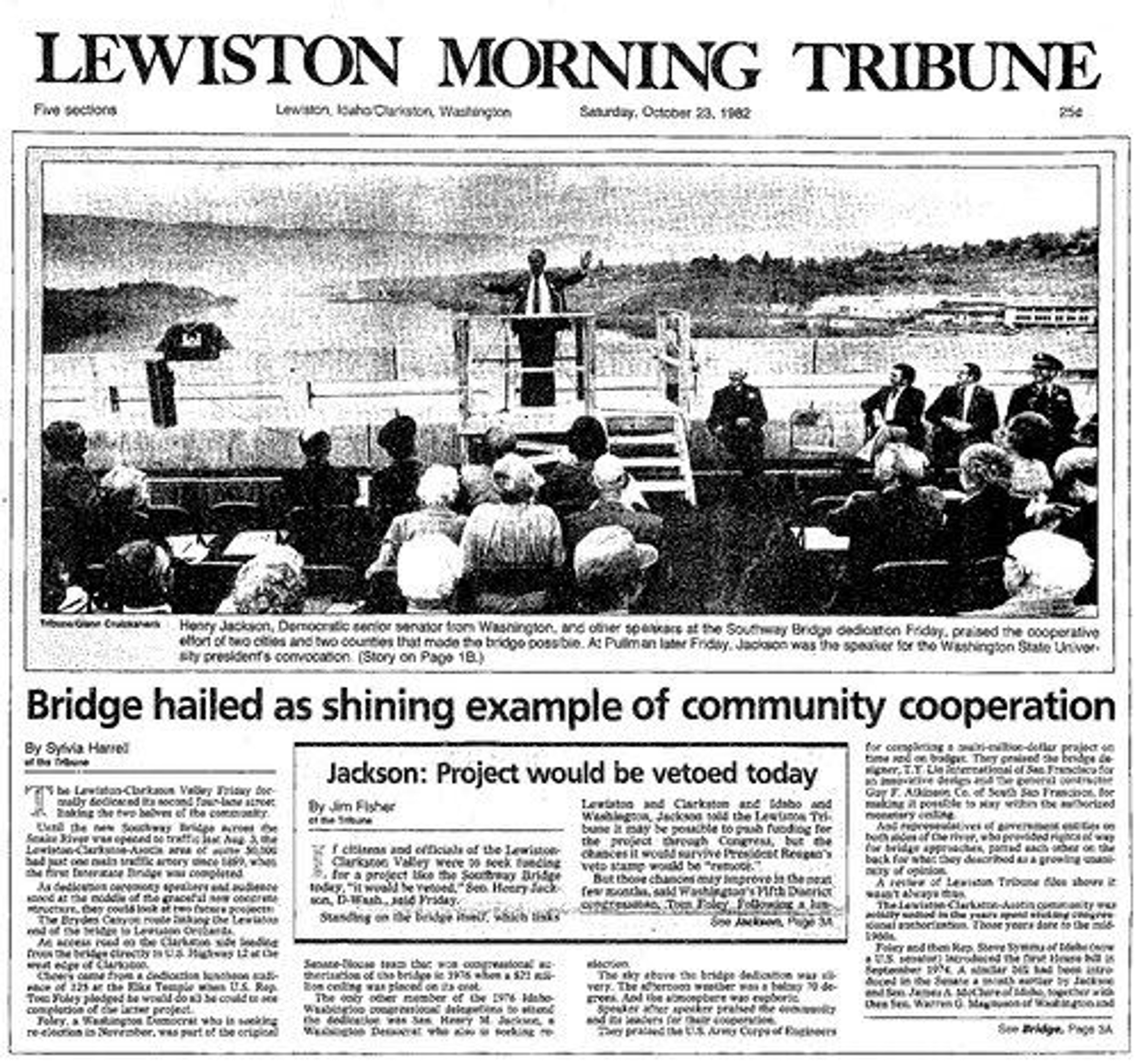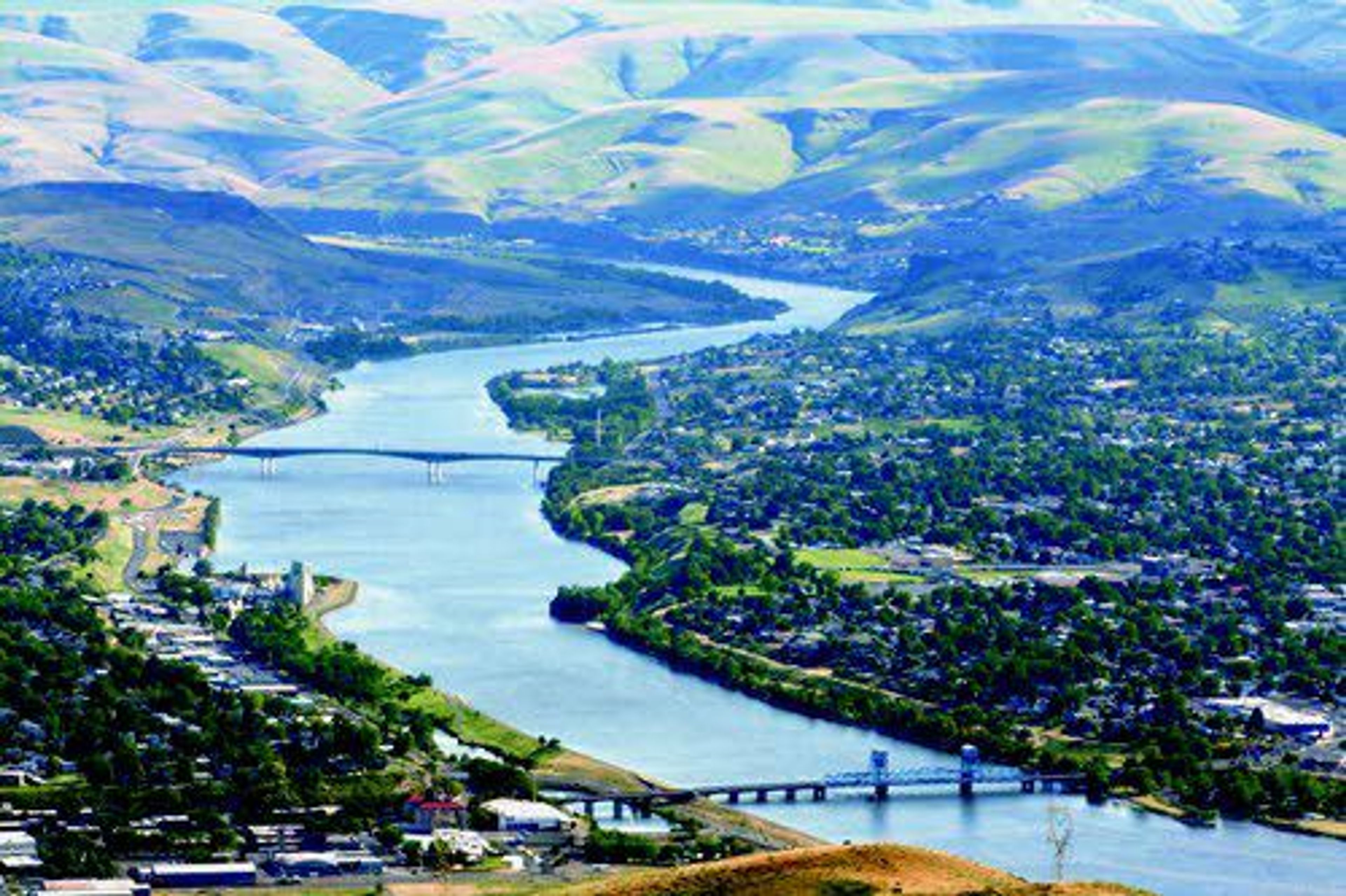The Tribune at 125: Bridge hailed as shining example of community cooperation
This article originally ran in the Oct. 23, 1982, edition of the Lewiston Tribune.
---
The Lewiston-Clarkston Valley Friday formally dedicated its second four-lane street linking the two halves of the community.
Until the new Southway Bridge across the Snake River was opened to traffic last Aug. 3, the Lewiston-Clarkston-Asotin area of some 50,000 had just one main traffic artery since 1899, when the first Interstate Bridge was completed.
As dedication ceremony speakers and audience stood at the middle of the graceful new concrete structure, they could look at two future projects:
The Bryden Canyon route linking the Lewiston end of the bridge to Lewiston Orchards.
An access road on the Clarkston side leading from the bridge directly to U.S. Highway 12 at the west edge of Clarkston.
Cheers came from a dedication luncheon audience of 125 at the Elks Temple when U.S. Rep. Tom Foley pledged he would do all he could to see completion of the latter project.
Foley, a Washington Democrat who is seeking re-election in November, was part of the original Senate-House team that won congressional authorization of the bridge in 1976 when a $21 million ceiling was placed on its cost.
The only other member of the 1976 Idaho-Washington congressional delegations to attend the dedication was Sen. Henry M. Jackson, a Washington Democrat who also is seeking re-election.
The sky above the bridge dedication was silvery. The afternoon weather was a balmy 70 degrees. And the atmosphere was euphoric.
Speaker after speaker praised the community and its leaders for their cooperation.
They praised the U.S. Army Corps of Engineers for completing a multi-million-dollar project on time and on budget. They praised the bridge designer, T. Y. Lin International of San Francisco for an innovative design and the general contractor Guy F. Atkinson Co. of South San Francisco, for making it possible to stay within the authorized monetary ceiling.
And representatives of government entities on both sides of the river, who provided rights of way for bridge approaches, patted each other on the back for what they described as a growing unanimity of opinion.
A review of Lewiston Tribune files shows it wasn't always thus.
The Lewiston-Clarkston-Asotin community was solidly united in the years spent seeking congressional authorization. Those years date to the mid-1960s.
Foley and then Rep. Steve Symms of Idaho (now a U.S. senator) introduced the first House bill in September 1974. A similar bill had been introduced in the Senate a month earlier by Jackson and Sen. James A. McClure of Idaho, together with then Sen. Warren G. Magnuson of Washington and Frank Church of Idaho.
The Senate bill won swift and unanimous approval - despite adverse testimony by Washington, D.C., officials of the corps who said the costs would exceed the need. The House bill got nowhere that year or the next.
At the dedication luncheon, Carl C. Moore of Lewiston, chairman of the Idaho Transportation Board, recalled that Magnuson, main speaker at the 1975 Port of Lewiston and Snake River Waterway dedication had - while fumbling for pocketed speech notes - turned to Moore and said:
"We're going to build that bridge you've been bugging me about and we're going to build it pretty soon."
"At that point," Moore told his audience, "I quit worrying about it."
Meanwhile, both halves of the community continued to press for congressional approval. A united delegation visited the national capital. Leaders submitted packets of letters and statements from 26 Washington and Idaho governmental units and public officials urging federal construction.
Despite continued opposition from top corps officials, congressional authorization came in the fall of 1976.
It was after the bill was signed into law by President Ford that unanimity at the community level began to fall apart.
More than two years of intermittent bickering ensued - over the precise location, the design of the ramps on either side, the properties needed for the rights of way, who should operate and maintain the bridge and, finally, over a legal roadblock that concerned liability.
At one point, Asotin County commissioners and Lewiston City Council members were - literally - a mile apart on the proposed location.
The corps even postponed a bid opening that had been scheduled for late 1977 on drilling to determine rock formations for bridge piers. The corps said there was no point in continuing until representatives of the two counties and two cities involved could agree on where the bridge should be built.
Meanwhile, inflation was humping along at about a 10 percent rate. Some bridge supporters worried inflation could push costs through the $21 million ceiling.
Finally, the last disagreement was resolved in June 1979.
But by then, the valley was only too aware that the Carter administration hadn't included funds to start the bridge in its 1979-1980 fiscal budget.
Magnuson, then chairman of the powerful Senate Appropriations Committee, fixed that. He inserted an $8.5 million appropriation in an omnibus bill that won approval, and construction of the bridge was assured.
On Jan. 24, 1980, the basic bridge construction contract of $15.9 million was awarded to the Atkinson firm as low bidder.
That wasn't the end of problems. Concrete construction was beset with a Teamster strike. The corps wasn't satisfied with some of the pre-stressed concrete work. And as the bridge neared completion early last summer, leaks in the deck developed. The leaks were sealed but the four governmental entities in the valley agreed to open the bridge for traffic only on condition that the corps would continue to be responsible for it for the next year.
The 1,750-foot-long bridge was constructed in segments from two main piers in the river. The structure has a main span of 610 feet that is at least 60 feet above the water, two side spans of 370 feet and approach spans of 200 feet each.
The 70-foot-wide bridge deck accommodates four traffic lanes, a median strip, a sidewalk on one side and a bicycle lane on the other.
Felix Kulka of San Francisco, president of T. Y. Lin International, told the dedication audience that, as a bridge designer, he doesn't like the heavy concrete top rail of the bridge.
Answering comments about it, Kulka said, "We regret the massiveness of the guard rail." But he said it is required by traffic safety regulations and "has to stop a truck that jumps the curb."
Although Foley, Jackson and others praised the corps, contractor, designer and community for completing a bridge on time and within budget, was that the case?
A check of corps records shows that to be mostly true.
A bitter strike and a bit of community dissention may have delayed completion from six months to a year. But earlier estimates of a 1981 completion may have been optimistic.
The bridge would have been well under the $21 million budget with the original plan: a T intersection with State Route 129 on the Clarkston side and one Lewiston ramp.
But Clarkston and Asotin County officials objected to the intersection and Lewiston and Nez Perce County wanted another ramp.
An overpass and an access ramp were built on the Clarkston side as part of the main construction contract. That didn't leave enough money for the second Lewiston ramp.
Congress had to increase the cost limitation to permit the ramp's construction - then told the corps to dig up the money out of its existing budget.
The second or north ramp on the Lewiston side, being constructed, by Slettin Construction Co. of Great Falls, Mont., for slightly less than $1.5 million, is scheduled for completion early next year.
The bottom line: Total cost of the entire Southway Bridge project, including engineering, supervision, administration, explorations and all other work stands at $22,350,000.










